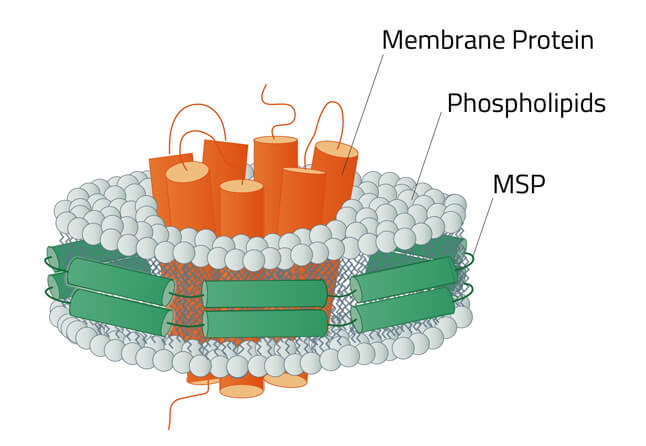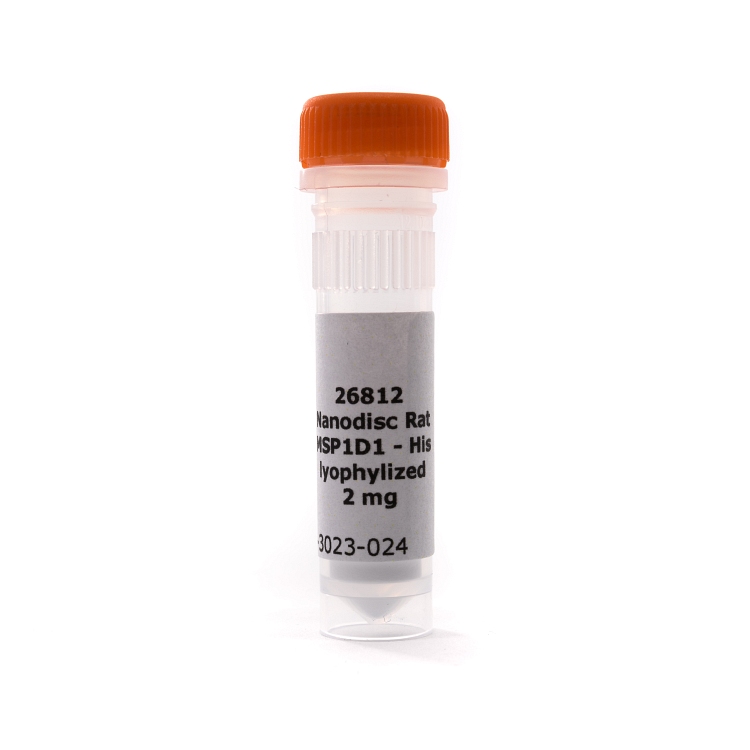rat MSP1D1-His, lyophilized protein
Order number: 26816
Description
Membrane scaffold proteins derive from apolipoprotein (apo; A-I). They are used in membrane protein sciences for the stabilization of membrane proteins in a lipid environment after the removal of the cell membrane. The size of the nanodisc is determined by the MSP that was used to create the disc. MSP1D1 (His-tagged) creates nanodiscs of 9-10 nm in diameter. This product contains a His-tag, keep that in mind when choosing the affinity tag for your membrane protein.
This product is available with different species as its background. This is important for e.g. for secondary antibodies of a western blot.
Other MSP products or related sites by Cube Biotech include:
This product is available with different species as its background. This is important for e.g. for secondary antibodies of a western blot.
Other MSP products or related sites by Cube Biotech include:

Datasheets
| Feature | |
|---|---|
| Available origins | Human, rat, mouse, alpaca |
| Purity | > 90% (Determined by SDS-PAGE) |
| Number of amino acids |
|
| Molecular Mass |
|
| Extinction coefficient (in water) ε280 |
|
| Buffer | 20 mM TRIS pH 7.4; 100 mM NaCl; 0.5 mM EDTA |
| Sequence (Human origin), for the other origins please send request | MGSSHHHHHH ENLYFQ GLKLLDNWDSVTSTFSKLREQLG PVTQEFWDNLE KETEGLRQEMS KDLEEVKAKVQ PYLDDFQKKWQEEMELYRQKVE PLRAELQEGARQKLHELQEKLS PLGEEMRDRARAHVDALRTHLA PYSDELRQRLAARLEALKENGG ARLAEYHAKATEHLSTLSEKAK PALEDLRQGLL PVLESFK VSFLSALEEY TKKLNTQ |
| Affinity tag | N-Terminal His-tag |
| Shipping Temperature | Room Temperature |
| Storage of lyophilized protein | -20°C for several months |
| Storage of reconstituted protein | 2-8°C for several days |
| Helpful literature references |
|
Citations
| Stabilized Protein | Year | Author |
|---|---|---|
| Nanolipoprotein particles | 2016 | Zeno F., Johnson K.E., Sasaki D.Y., Risbud S.H., Longo M.L. |
| BSA | 2019 | Damiati S., Scheberl A., Zayni S., Damiati S.A., Schuster B., Kompella U.B. |
| Look at Publication | 2021 | Nobali S.C., Di Rosa M.C., Rauh O., Thiel G., REina S., De Pinto V. D. |
Video
Watch our video tutorial about the creation of MSP nanodiscs. It explains the whole process, starting with the initial solubilization using detergents. The protein that was stabilized in this demonstration was Bacteriorhodopsin.
We also recommend our video guide to nanodiscs in general.
We also recommend our video guide to nanodiscs in general.
FAQ
Can I get the datasheet for the MSP1D1 (His-tagged) protein?
Is this the correct MSP product for my membrane protein?
This cannot be answered easily as every membrane protein performs differently with each nanodisc size and phospholipid. It usually requires a screening process before. Remember that membrane proteins with fewer transmembrane domains (TMD) require a smaller nanodisc, while a high number of TMDs need a larger nanodisc.
Why are there different origins for the MSP protein and do they work differently?
First, no they all work the same. Do not worry. Second, the origin of the MSP protein is of importance e.g. western blots. As the secondary antibody is usually against a species e.g anti-mouse. To avoid unwanted cross reactions the origin of the MSP protein must be known.
I have never worked with MSP nanodiscs before. Can you tell me more about them?
Of course! We created THIS MSP NANODISC GUIDE PAGE, for this purpose. Have a look at it!
Are there other options to stabilize membrane proteins besides MSP nanodiscs?
Yes, there are. We recommend synthetic copolymer nanodiscs greatly! Have a look at THIS GUIDE PAGE to learn more.



